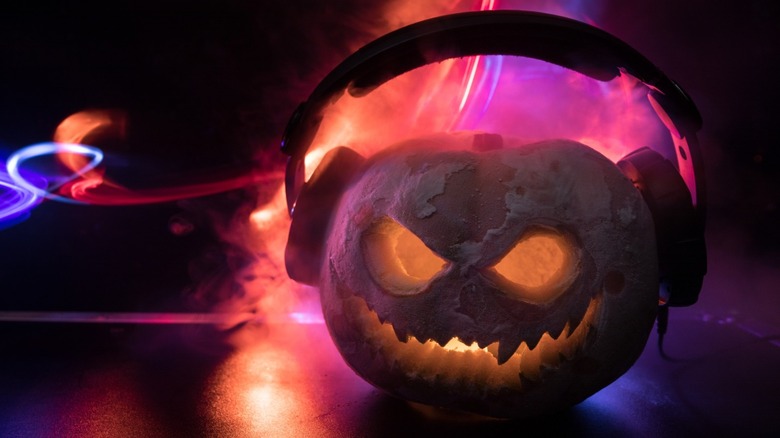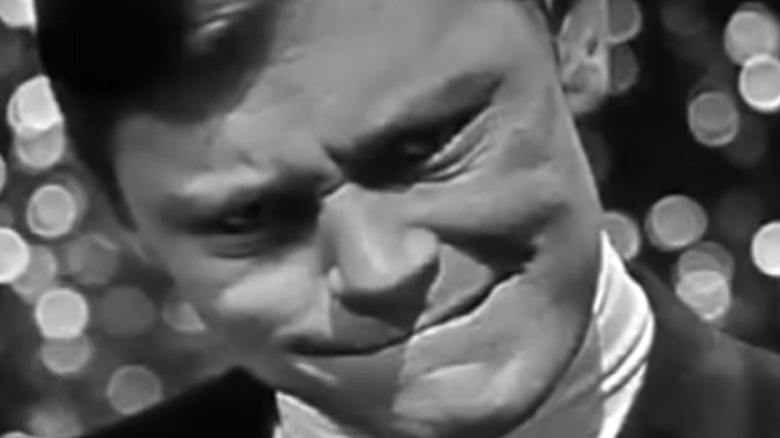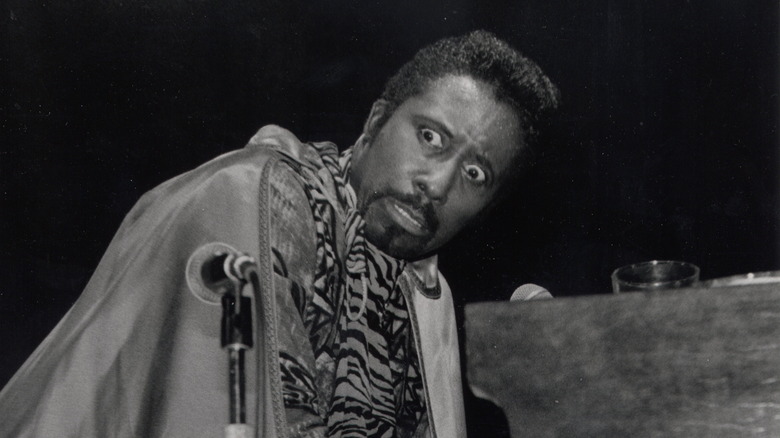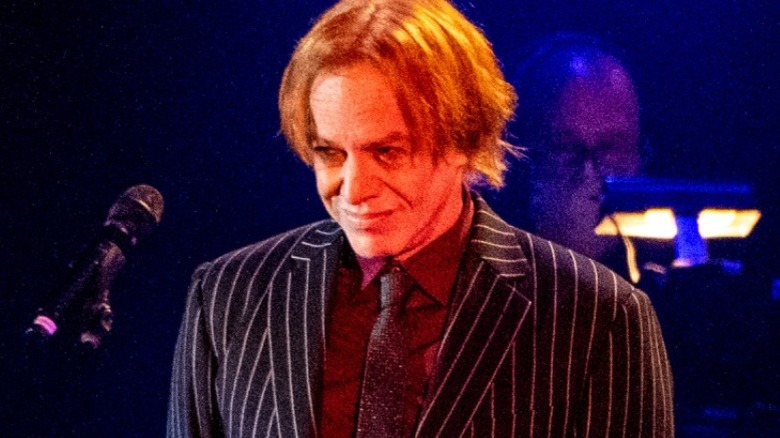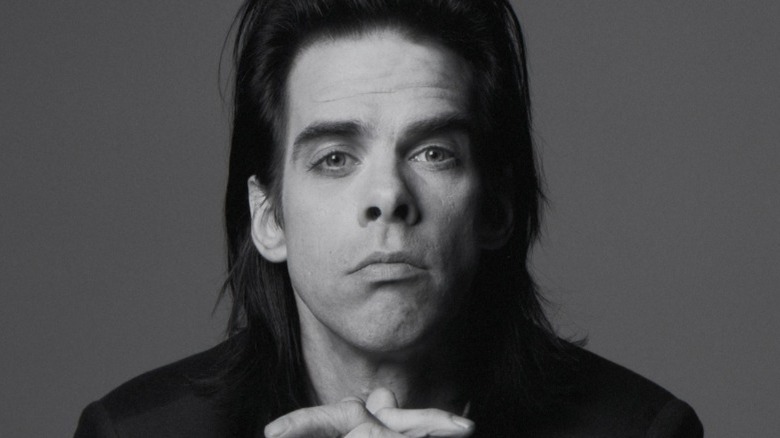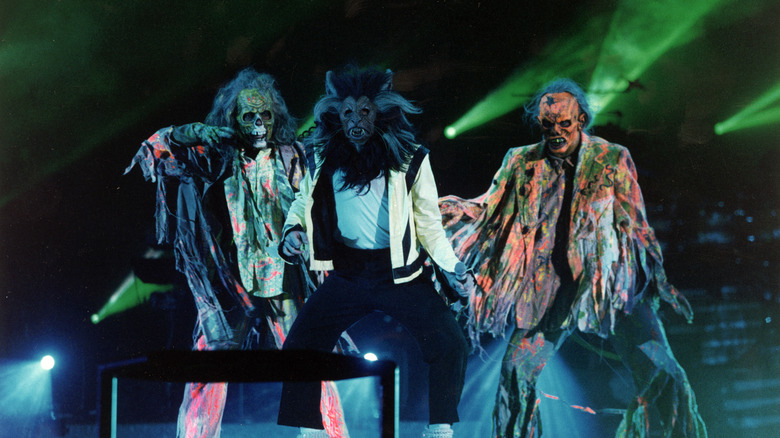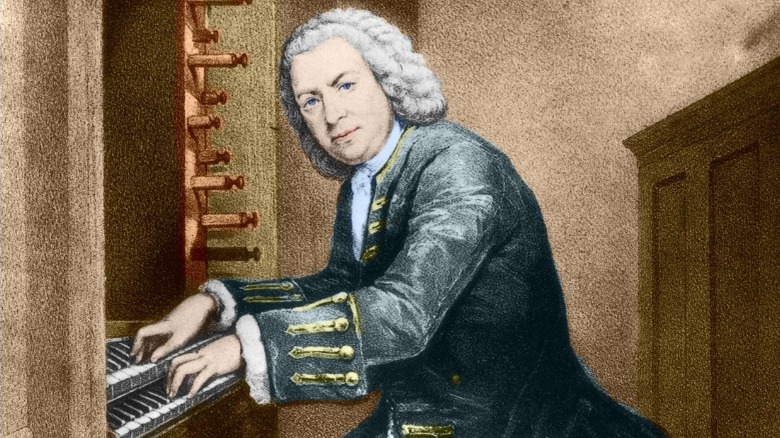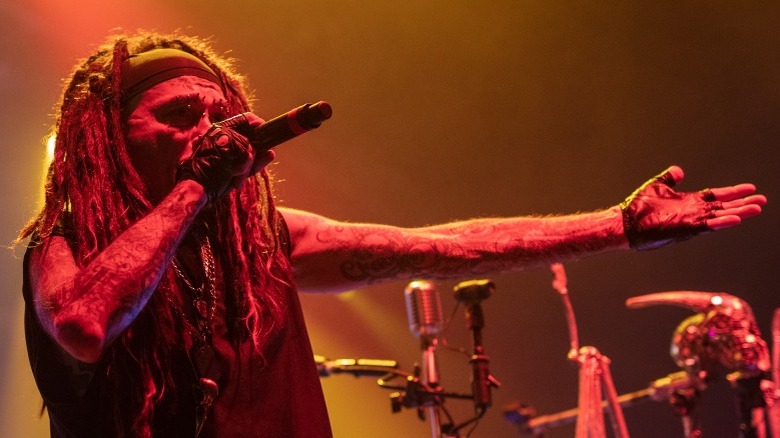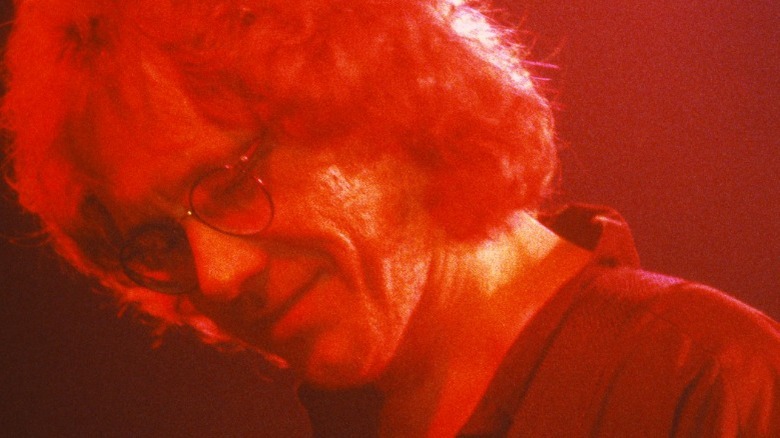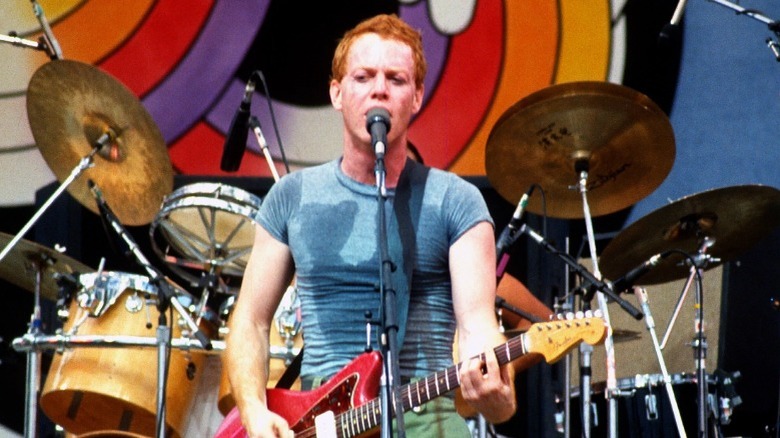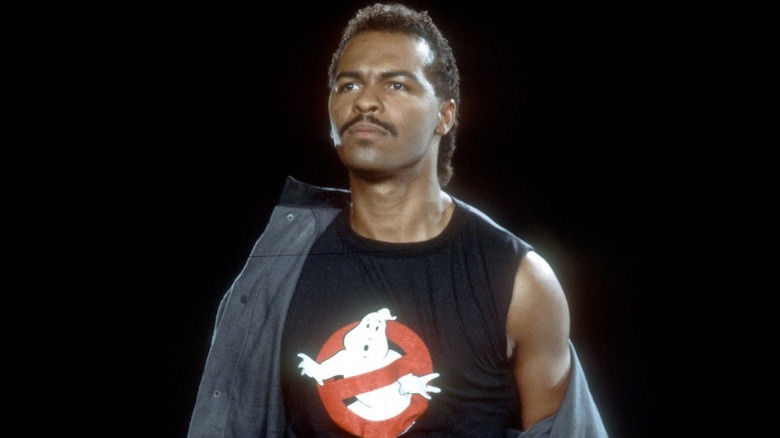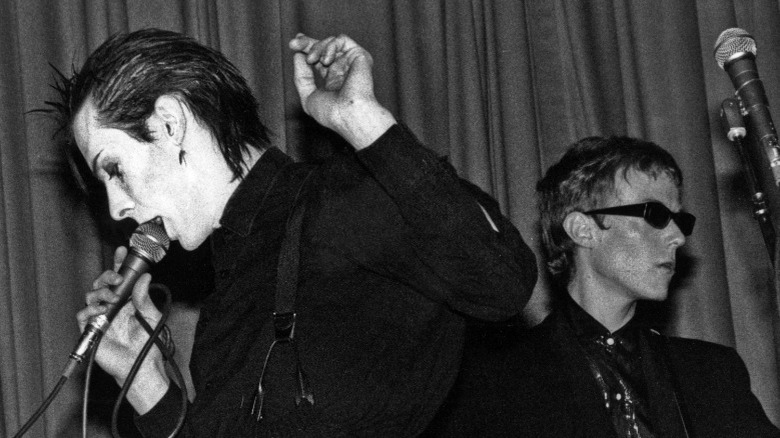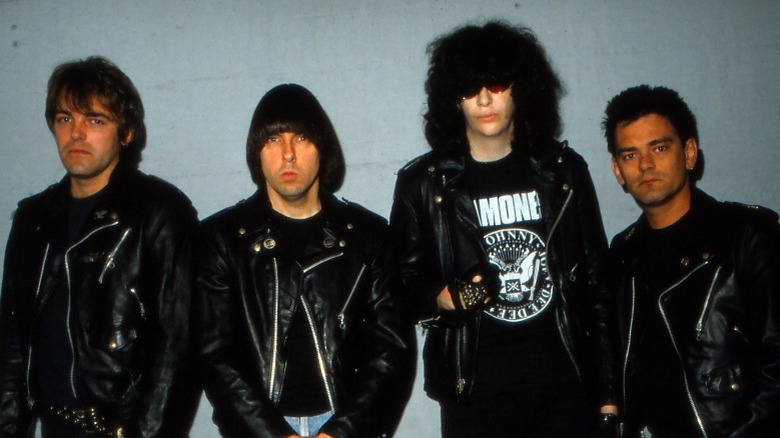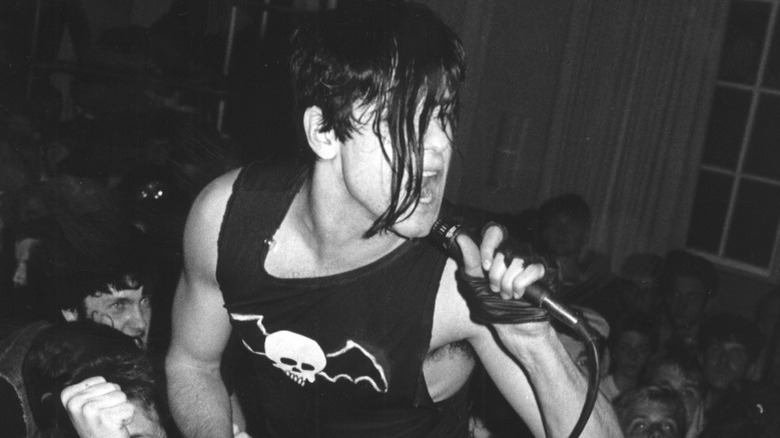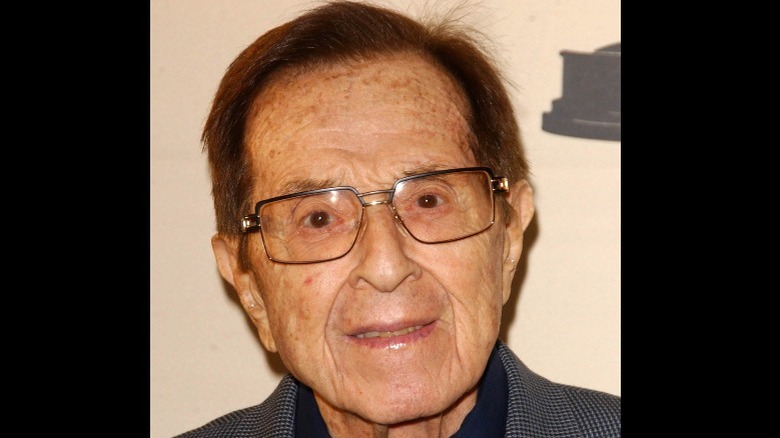The Stories Behind Popular Halloween Songs
As the days grow shorter and the nights chillier, the Halloween decorations come out of the garage, grocery stores turn orange, and certain songs emerge from the ether for their glory days. Just as Mariah Carey's "All I Want for Christmas is You" signals the arrival of Santa Claus, a handful of tunes have become affiliated with spooky season. According to The New York Times, Spotify data indicates that Halloween music streaming increases about two weeks before October 31, spiking on the day itself or the Saturday before it — likely when Halloween parties are in full swing. But compared to Christmas music, which tends to be pretty cut-and-dry both thematically and musically, the concept of what constitutes a Halloween song is a little murkier.
Some Halloween songs merely mention monsters or killers in the lyrics, while others seem completely unrelated but are linked to movies or motifs that have become Halloween staples. A select few, like those found on horror movie soundtracks, utilize techniques that make the listener feel unsettled or downright creeped out. As The Current notes, many Halloween songs feature tritones, which are ratios of complex frequencies that create a feeling of unease once known as "the devil's interval." Others use ostinato, which is the stressful repetition of musical structures that give the "Jaws" and "Halloween" movie themes their terror-inducing vibes. But how exactly did listening to this bizarre hodgepodge of songs become an annual tradition? Here are the stories behind some of the most popular Halloween songs.
Bobby 'Boris' Pickett and the Crypt-Kickers – Monster Mash
It wouldn't be Halloween without this "graveyard smash." According to NME, inspiration for the 1962 song came when actor and singer Bobby Pickett started doing an impression of horror actor Boris Karloff during performances with his band the Cordials. It was such a crowd-pleaser that his bandmate, Lenny Capizzi, encouraged him to record an entire song around the idea. Pickett was hesitant at first as he wasn't sure mimicking was a good career move, but eventually, the man who would go on to sing "Monster Mash" agreed.
Pickett and Capizzi, both avid horror movie fans, wrote the song in about an hour. As American Songwriter notes, Capizzi played the piano and Pickett sang his best Karloff (with a cameo by Bela Lugosi's Dracula). In the studio, producer Gary Paxton embellished the simple surf rock tune with creative low-budget sound effects: blowing a straw into a water glass simulated a bubbling cauldron, dragging chains across a linoleum floor emulated a dancing Frankenstein, and pulling a rusty nail out of a board gave the impression of a creaky coffin opening.
Record labels weren't initially keen on the song, so Paxton (convinced it was a hit) pressed 500 copies himself and hand-delivered them to radio stations across California. His efforts paid off and the song became a massive success. Only the BBC considered it too "morbid" for airplay, though by 1973 they too were doing the Monster Mash.
Screamin' Jay Hawkins – I Put a Spell on You
While many covers of this song now exist, including a witchy performance in "Hocus Pocus", the version by Screamin' Jay Hawkins' in 1956 came first. According to 500 Songs, Hawkins penned the lyrics in 1954 after his girlfriend left him, claiming he would put a spell on her to inspire her to return. But it wasn't released.
Two years later, Hawkins signed to a bigger record label and they wanted a new recording of the song. Producer Arnold Maxim knew Hawkins and his band put on passionate live shows, but they struggled to come to life in the studio. So, he ordered some beer and told them it was a party. Once they were good and loosened up, Maxim began to record — and the eccentric "I Put a Spell on You," full of chaotic, soulful yells, was the result.
After the song's success, Hawkins transitioned from a blues artist to the first shock rocker. He cultivated a voodoo-inspired image by wearing capes and a bone in his nose. Later, he incorporated a smoking skull on a stick, a rubber snake, and a coffin, which he would rise out of at the start of shows. Per The Current, he also used pyrotechnics and cast staged spells. Teens especially enjoyed his antics, as horror was on the rise. Future acts like Gwar, The Cramps, and Alice Cooper later emulated his theatrical style.
Danny Elfman – This is Halloween
As the opening song to the 1993 Tim Burton stop-animated film "The Nightmare Before Christmas," "This is Halloween" intentionally cultivates as many Halloween vibes as possible. According to Cartoon Research, Burton based the movie's plot on the classic poem "The Night Before Christmas." Only instead of focusing on Santa Claus, he tells the story of Jack Skellington, a skeletal figure from Halloween Town who takes an interest in Christmas. He wanted the music to be a central part of the film so he hired his friend, composer Danny Elfman, to score it.
The pair started working on the project with only three pages of notes and some rough sketches — the script would not be written until way later. For each scene, Burton provided a piece of the story, including the key events and characters' emotions, and Elfman wrote a piece of music to fit it. According to Elfman, the process was effortless: "He starts telling a story; I start hearing music. It usually ends up being about that simple."
"This is Halloween" is sung by the citizens of Halloween Town as an introduction and is an ode to the holiday, referencing pumpkins, snakes, spiders, and trick-or-treating. As Classic FM notes, the song makes listeners feel uneasy due to its unpredictable time signature changes, emphasized off-beats, syncopated rhythms, variety of minor keys, and repeated descending three-note "Hall-o-weens." As the characters sing in the song, "Life's no fun without a good scare."
Nick Cave and the Bad Seeds – Red Right Hand
With its plodding rhythm, the growly voice of Nick Cave, and a title that suggests a killer on the loose, 1994's "Red Right Hand" is sinister indeed. As The New York Post notes, the song grew out of a jam session. Cave wasn't initially that enthused about it, but his band convinced him to write lyrics to fit the ominous groove.
According to Far Out Magazine, Cave drew inspiration from John Milton's epic poem "Paradise Lost," the literary work credited with making Satan a seductive figure rather than a mere monster. The song even takes its title from a line in the poem. At the time, Cave was attending church in the morning and visiting his drug dealer in the afternoon, and the song expresses Milton's personal battle between heaven and hell. He filled a notebook as he created his prowling red-right-handed character who, according to Cave's bandmate Mick Harvey, was "seemingly part deity, part demon."
Once released, the song took on a life of its own. It first gained a spooky reputation when it occurred in a 1996 episode of "The X-Files" and became cemented in pop culture when it was featured in the first three "Scream" movies (via The New York Post). Two decades later, it saw a resurgence as the theme song to "Peaky Blinders." Ever the poet, Cave claims that the song — now his biggest hit — has "followed him around like a junkyard dog" (per Financial Times).
Michael Jackson – Thriller
Michael Jackson's 13-minute music video for "Thriller" was released on December 2, 1983, but that didn't stop it from becoming the official Halloween anthem for all eternity. As American Songwriter notes, the song's title came easily to songwriter Rod Temperton upon waking up one day. With visions of horror-themed merchandise in his head, he wrote the spooky lyrics in around one hour, had Jackson sing a few, and hired horror actor Vincent Price to perform the spoken word part, which he wrote on the way to the studio. Per Vox, the song was begrudgingly released as the third single off Jackson's 1982 album "Thriller," following up "Billie Jean" and "Beat It."
In keeping with the macabre theme, Jackson hired John Landis, the director of the 1981 cult classic horror-comedy, "An American Werewolf in London." With a hefty price tag of $900,000, the video featured dancing zombies, creaking doors, Price's goth poetry and spine-tingling laugh, those infamous tritones (via The Current), Jackson as both a zombie and a werecat, and an intense disclaimer warning viewers about the occult necessitated by Jackson's then-status as a Jehovah's Witness. Actually, for this reason, Jackson intitially wanted to destroy the "Thriller" music video before its debut altogether. To say the song was a success is an understatement. Though the label initially dismissed it as a novelty song, Vox notes that "Thriller" became the highest-selling album of all time, forever changing the music video world and inspiring generations of dance-offs and flash mobs.
Johann Sebastian Bach – Toccata and Fugue in D Minor
Listen to the first few seconds of this classical piece and visions of Victorian castles and distinguished vampires will immediately spring to mind. It's an oldie with a mysterious history. Per Britannica, Johann Sebastian Bach likely wrote the song before 1708. It's a two-part composition, opening with the intense up-and-down toccata and closing with the gentler repeated overlayed melodies of the fugue.
According to Classical 90.5 KMUC, Bach was working as a music director in Leipzig, Germany at the time and was going through an organ phase. Still, some scholars doubt that he wrote "Toccata and Fugue." The original song manuscript lists the young composer and organist Johannes Ringk as its author. Sadly, the truth may never be known. In fact, the song itself was all but lost to time until composer Felix Mendelssohn started exploring Bach's more obscure offerings in the 1800s. He resurrected "Toccata and Fugue" in 1833 and by 1870 it was considered a Bach staple.
In 1931, the song was used as an accompaniment for the silent film "Dr. Jekyll and Mr. Hyde" and became associated with all things suspenseful and dark. As Royal S. Brown notes in his book "Overtones and Undertones," horror actor Boris Karloff later plays the piece in 1934's "The Black Cat," further solidifying its spooky reputation. Furthermore, the song is performed in the key of D minor. According to Musical U, minor keys in general are associated with sadness and fear.
Ministry – Everyday (is Halloween)
According to a 1991 issue of Spin Magazine, Ministry started their career as an upbeat early-80s Europop act but quickly about-faced, becoming a pioneer of gritty industrial rock in the '90s. Al Jourgensen, the mastermind behind Ministry, had grown tired of producing poppy hits like "Work for Love" for the major label Arista. As explained in "Alternative Rock": "They sign you because you're unique, then they try to make you sound like somebody else."
After Arista dropped Ministry, Jourgensen returned to the underground scene where he had more creative control. He signed with the indie label Wax Trax! Records and released a new single to herald the band's comeback in 1984. While "All Day" was the A-side, the single's synthpop B-side, "Everyday (is Halloween)," became a sleeper hit. With its spooky vibes, unapologetic otherness, and lyrics like "to me every day is Halloween; I have given up hiding and started to fight" (per Genius), the catchy bop quickly caught on. As Thompson notes, the song was "adopted as the anthem of America's disenfranchised gothic community."
Warren Zevon – Werewolves of London
Warren Zevon was a talented musician and songwriter with many other offerings, but his 1978 song about well-dressed beef lo-mein-eating werewolves is by far his most famous. According to American Songwriter, inspiration for the zany classic came when Phil Everly, of The Everly Brothers fame, mentioned watching the 1935 horror film "Werewolf of London." Zevon immediately rolled with the concept of a city-dwelling werewolf who, though cultured, nonetheless still devours people every full moon.
Guitarist LeRoy Marinell quickly came up with a riff and bandmate Waddy Wachtel wrote the first verse, in which a werewolf holds a Chinese menu in SoHo. Zevon then adapted the guitar to piano and the crew wrote the rest of the lyrics, which describe perfect-haired werewolves drinking piña coladas, attacking little old ladies, and, as Lon Chaney Jr., walking with the queen. Luckily, Zevon's then-wife Crystal managed to capture the moments of genius in writing.
Recording it in the studio was a challenge, as the band felt every attempt came off cutesier than they intended. After 50 takes — several, including the final version, featuring Mick Fleetwood and John McVie of Fleetwood Mac — they opted for a simple piano and guitar arrangement. While Zevon did not want it to be the album's first single and later disparaged his creation, the label pushed for its release. It became a smash hit.
Oingo Boingo – Dead Man's Party
Falling somewhere between art punk, ska, and new wave, Oingo Boingo was quite a sensation in the 1980s, especially in their native Los Angeles. Fronted by Danny Elfman, who Stereogum notes would go on to score over 100 films, Oingo Boingo had their first big hit with 1985's "Weird Science," a song they had written for the movie of the same name. As Elfman told Stereogum, he was scoring another film, 1986's "Back to School," when the filmmakers suggested his band play in a scene.
Per Totally '80s, they performed their upbeat 1985 song "Dead Man's Party" which, despite its spooky imagery, took over the airwaves that June. Lyrically, the song is a clever take on a funeral, as evidenced in lines like "I'm all dressed up with nowhere to go," "shiny silver dollar on either eye," and "leave your body and soul at the door" (per Genius). Elfman also makes a nod to a ghost story by E.F. Benson called "The Bus Conductor," in which a hearse driver ominously claims that "there's room for maybe just one more" — a line he sings in the song (via Totally '80s).
Oingo Boingo was known for its annual Halloween concerts and use of skeleton imagery until the band disbanded in 1995. In fact, UDiscover notes that Elfman's friend and collaborator Tim Burton once claimed "all his shows were very Halloween-based" — likely the main reason he asked Elfman to score "The Nightmare Before Christmas."
Ray Parker Jr. – Ghostbusters
Things weren't going smoothly during the filming of 1984's "Ghostbusters." According to Screen Rant, the script had to be rewritten multiple times, there were budget issues, and the project was behind schedule. Late in the game, the filmmakers were desperate for a theme song. As the legend goes, they even reached out to Lindsay Buckingham of Fleetwood Mac for a quick composition. Luckily, semi-retired session guitarist Ray Parker Jr. was in Los Angeles at the time and reluctantly agreed to help.
As Parker told "America's Top 10" in 1984, Columbia Pictures had reviewed and vetoed around 60 other potential songs before they called him in a panic. He was then given the impossible task of creating a theme song in only two days. Per Screen Rant, the guitar part came quickly but he struggled with the lyrics until he saw the Ghostbusters commercial that would be used in the film. Inspired by cheesy '80s television ads, he wrote the song as a jingle, leading to the iconic line "who ya gonna call?" Of course, Parker and Huey Lewis had a controversy, and Lewis and the News sued Parker for plagiarizing their song "I Want a New Drug" (per Entertainment Weekly). But that didn't stop "Ghostbusters" from dominating the charts and becoming one of the most beloved spooky hits of all time.
Bauhaus – Bela Lugosi's Dead
In a retrospective interview with Uncut Magazine, Bauhaus frontman Peter Murphy described their biggest song, "Bela Lugosi's Dead," as "the 'Stairway to Heaven' of the 1980s." According to guitarist Daniel Ash, the idea for the song came about when he was experimenting with a haunting guitar riff at the same time their bassist developed a fascination with Bela Lugosi, the actor famous for playing Dracula in the 1931 horror classic of the same name. Drawn to the bizarre allure of Lugosi's Dracula, Murphy was quickly on board.
The band's bassist wrote the song's vampiric lyrics, including the classic lines "the bats have left the bell tower" and "white on white translucent black capes" (per Genius), while biking home from work one day. At rehearsal, all of the pieces came together naturally: the suspenseful bass line, the dissonant bossa nova guitar part, and, of course, Murphy's otherworldly vocals. As Ash spookily notes, "It was like something else wrote it for us." The epic nine-and-a-half-minute song was recorded in a single take during the band's first trip to a studio.
"Bela Lugosi's Dead" was released as a single in August 1979 and was later featured in the opening sequence of 1983's vampire classic starring David Bowie, "The Hunger." As Far Out Magazine notes, it is now regarded as the first goth song and signaled the transition from post-punk to the gloomy, black-eyelinered, death-focused music later cemented by bands like The Cure and Siouxsie and the Banshees.
The Ramones – Pet Sematary
The story of The Ramones' catchy song "Pet Sematary" is steeped in lore. As Marky Ramone told it in his 2015 book, "Punk Rock Blitzkrieg," Stephen King handed Dee Dee Ramone a copy of "Pet Sematary," while serving the band dinner in his spooky basement. But, as King later noted in an interview with Rolling Stone, the dinner actually took place at a fancy restaurant and most of the band's members were incoherent. King told his publisher that while Marky's story was false, he supported it, stating: "When the truth and legend are in opposition, print the legend." What remains true is King's love for The Ramones. He even mentioned the band in his 1983 book "Pet Sematary," a horror novel about a supernatural graveyard that reanimates corpses in terrifying zombie form.
When it came time to add music to its 1989 film adaptation, The Ramones were an obvious choice. As director Mary Lambert told TIDAL, she asked her friend Dee Dee to write a song for the movie. According to producer Daniel Rey, Dee Dee read the book and penned the comically straightforward lyrics in around five hours that same day. Studio producer Jean Beauvoir added that it took two weeks to record the raw song with Joey Ramone's vocals and a few touches to give it commercial appeal. While the upbeat punk horror song wasn't an instant classic and even won a Razzie in 1990, it is now a must on all Halloween playlists.
Misfits – Halloween
While short-lived and now mostly the stuff of music legend, the Misfits inspired many future bands during their brief tenure. According to Last FM, the group formed in New Jersey in 1977 and, over the course of their six years together, became known for their annual Halloween shows. They also invented the genre of horror punk. By 1979, the Misfits had taken a skull face logo from a 1946 serial called "The Crimson Ghost," started wearing makeup and skeleton garb, and created the now-infamous hairstyle the "devilock."
Appropriately, the Misfits released "Halloween," a song that perfectly encompasses the darker aspects of the American holiday, as a single on October 31, 1981. On the peppy punk song, a young Glenn Danzig sings of "pumpkin faces in the night," "burning bodies hanging from poles," and "candy apples and razor blades" over a distorted guitar riff. "Halloween" and its even spookier Latin-versed B-side, "Halloween II," were both recorded during the summer of 1981 as part of what the band intended to be a full-length release (per Last FM).
But by 1983, the group had disbanded with primary songwriter and frontman Danzig going on to form Samhain and, later, his self-titled solo act. Still, "Halloween" remains a seasonal anthem, and many bands, including AFI and Dropkick Murphys, have covered it over the years (via Music Times). Danzig, meanwhile, continues to be a fan of the holiday, telling Revolver Magazine in 2010: "Man, every day is Halloween for me."
Vic Mizzy – The Addams Family
Second to the organ, few things scream Halloween quite like the finger snaps and harpsichord intro of "The Addams Family" theme. According to Screen Rant, the catchy 1964 television ditty was written by Victor Mizzy, a songwriter who created popular music from the 1930s through the 1960s. Some of his songs were even performed by Doris Day, Billie Holiday, and Dean Martin.
In addition to writing the theme, Mizzy directed the opening credits of "The Addams Family," positioned the cast members, and made sure their finger snaps matched the track. As noted by NPR, he used a click track to ensure that the timing was just right. Mizzy wrote the song's lyrics to effectively summarize the premise of the show and its "all together ooky" characters. He also sang them himself — overdubbing his vocals three times to capture the right feel — and played the harpsichord.
Though he was a talented songwriter for many decades, "The Addams Family" theme became one of his best-known works and he luckily retained the publishing rights to the song. Mizzy once joked to a CBS interviewer (via Reuters): "Two finger snaps and you live in Bel-Air." The song has been featured in all subsequent Addams Family films, remains a staple at sporting events, and, of course, makes an annual appearance every Halloween.
